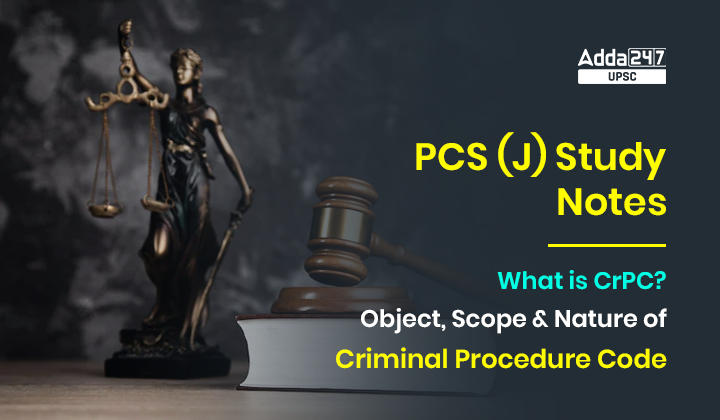Table of Contents
What is CrPC? Object, Scope and Nature of Criminal Procedure Code
What is CrPC?
The Criminal Procedure Code (CrPC) is the primary piece of legislation in India governing the administration of substantive criminal law. The full form of CrPC is “Criminal Procedure Code”.CrPC was passed into law in 1973 and went into effect on April 1, 1974.
Object of CrPC
The tools to determine guilt or innocence, collect evidence, try cases, and punish offenders are all provided by CrPC. In addition to addressing matters of public annoyance, crime prevention, and the support of a spouse, dependent children, or elderly parents, the Criminal Procedure Code also addresses similar matters. There are currently 565 parts, 5 schedules, and 56 forms within the act. There are a total of 46 chapters throughout the parts.
Scope of CrPC
First, in the enforcement of India’s criminal legislation. Secondly, methods and devices used to probe criminal activity, apprehend suspects, gather evidence, establish guilt or innocence, and sentence offenders.Trespassing on public property is a third category.The fourth goal is crime avoidance.Supporting a family of four is priority number five.
Nature of CrPC
The CrPC is, as its name implies, a body of law governing the procedure of criminal trials. It is considered comprehensive in scope. However, the court has the authority to construct law where there is none under the CrPC.
Difference between the Indian Penal Code, 1862 and Criminal Procedure Code, 1973
Both the Indian Penal Code (IPC) and the CrPC are parts of Indian law, though the former is more substantive than the latter. The IPC lists several offences and divides them up into various subcategories. Penalties and punishments for each offence are clearly spelled forth in the Code. On the other hand, the Criminal Procedure Code lays out the steps law enforcement must take while investigating a possible violation of any of the crimes listed in the penal codes.
IPC was enacted to serve as the country’s primary penal code, outlining the rules for punishing criminals. Contrarily, the primary goal of the CrPC is to establish mandatory practises that must be implemented during the conduct of a criminal trial. The IPC does not include provisions for courts or the Magistrate’s authority, although the CrPC, 1973 does.
सीआरपीसी क्या है? आपराधिक प्रक्रिया संहिता का उद्देश्य, दायरा और प्रकृति
सीआरपीसी क्या है?
आपराधिक प्रक्रिया संहिता (सीआरपीसी ) भारत में मूल आपराधिक कानून के प्रशासन को नियंत्रित करने वाला प्राथमिक कानून है। सीआरपीसी का पूर्ण रूप “आपराधिक प्रक्रिया संहिता” है। सीआरपीसी को 1973 में कानून में पारित किया गया था और 1 अप्रैल, 1974 को लागू हुआ था।
सीआरपीसी का उद्देश्य
दोष या निर्दोषता निर्धारित करने, साक्ष्य एकत्र करने, मामलों की सुनवाई करने और अपराधियों को दंडित करने के उपकरण सभी सीआरपीसी द्वारा प्रदान किए जाते हैं। सार्वजनिक झुंझलाहट, अपराध की रोकथाम, और जीवनसाथी, आश्रित बच्चों, या बुजुर्ग माता-पिता के समर्थन के अलावा, आपराधिक प्रक्रिया संहिता भी इसी तरह के मामलों को संबोधित करती है। अधिनियम में वर्तमान में 565 भाग, 5 अनुसूचियां और 56 रूप हैं। पूरे भागों में कुल 46 अध्याय हैं।
सीआरपीसी का दायरा
सबसे पहले, भारत के आपराधिक कानून के प्रवर्तन में। दूसरे, आपराधिक गतिविधि की जांच करने, संदिग्धों को पकड़ने, सबूत इकट्ठा करने, दोष या बेगुनाही स्थापित करने और अपराधियों को सजा देने के लिए इस्तेमाल किए जाने वाले तरीके और उपकरण। सार्वजनिक संपत्ति पर अतिक्रमण तीसरी श्रेणी है। चौथा लक्ष्य अपराध निवारण है। चार लोगों के परिवार का समर्थन करना प्राथमिकता नंबर पांच है।
सीआरपीसी की प्रकृति
सीआरपीसी, जैसा कि इसके नाम से पता चलता है, आपराधिक मुकदमों की प्रक्रिया को नियंत्रित करने वाला कानून है। इसका दायरा व्यापक माना जाता है। हालांकि, अदालत के पास कानून बनाने का अधिकार है जहां सीआरपीसी के तहत कोई नहीं है।
भारतीय दंड संहिता, 1862 और आपराधिक प्रक्रिया संहिता, 1973 के बीच अंतर
भारतीय दंड संहिता (आईपीसी) और सीआरपीसी दोनों ही भारतीय कानून के हिस्से हैं, हालांकि पूर्व बाद की तुलना में अधिक महत्वपूर्ण है। आईपीसी कई अपराधों को सूचीबद्ध करता है और उन्हें विभिन्न उपश्रेणियों में विभाजित करता है। संहिता में प्रत्येक अपराध के लिए दंड और दंड स्पष्ट रूप से दिए गए हैं। दूसरी ओर, आपराधिक प्रक्रिया संहिता दंड संहिता में सूचीबद्ध किसी भी अपराध के संभावित उल्लंघन की जांच करते समय कानून प्रवर्तन द्वारा उठाए जाने वाले कदमों का वर्णन करती है।
आईपीसी को अपराधियों को दंडित करने के नियमों को रेखांकित करते हुए देश की प्राथमिक दंड संहिता के रूप में लागू किया गया था। इसके विपरीत, सीआरपीसी का प्राथमिक लक्ष्य अनिवार्य प्रथाओं को स्थापित करना है जिन्हें एक आपराधिक मुकदमे के संचालन के दौरान लागू किया जाना चाहिए। आईपीसी में अदालतों या मजिस्ट्रेट के अधिकार के प्रावधान शामिल नहीं हैं, हालाँकि सीआरपीसी, 1973 करता है।
FAQs
1. When did CrPC went into effect?
Ans: CrPC went into effect on April 1, 1974.
2. Why IPC was enacted?
Ans: IPC was enacted to serve as the country’s primary penal code, outlining the rules for punishing criminals.




 TSPSC Group 1 Question Paper 2024, Downl...
TSPSC Group 1 Question Paper 2024, Downl...
 TSPSC Group 1 Answer key 2024 Out, Downl...
TSPSC Group 1 Answer key 2024 Out, Downl...
 UPSC Prelims 2024 Question Paper, Downlo...
UPSC Prelims 2024 Question Paper, Downlo...




